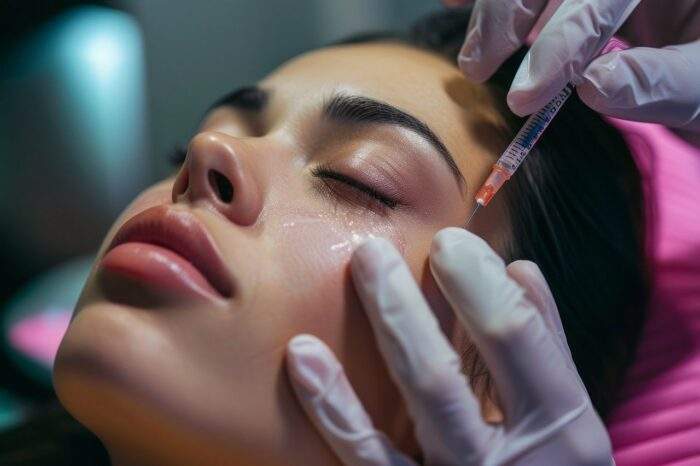Understanding Botox: Navigating Aesthetic Enhancements for a Natural Look

Table of Contents
- The Basics of Botox: What It Is and How It Works
- Deciding if Botox Is Right for You: Factors to Consider
- The Procedure: From Consultation to Aftercare
- Safety and Side Effects: What the Research Says
- The Cost of Beauty: Budgeting for Botox
- Botox Beyond Aesthetics: Therapeutic Uses and Advances
- Choosing a Qualified Botox Provider: The Key to Natural Results
- Empowering Your Decision: Resources and Support for Botox Candidates
Key Takeaways
- Botox is a cosmetic treatment that uses injections to reduce wrinkles and fine lines and enhance a person’s appearance without surgery.
- Understanding what to expect, the procedure, and post-care is essential to achieve the best possible results.
- Choosing a qualified and experienced practitioner for natural-looking and safe results is crucial.
The Basics of Botox: What It Is and How It Works
Botox, or botulinum toxin, is a protein with a unique ability to interrupt the neuromuscular signals that cause muscles to contract temporarily. In aesthetic applications, Botox helps soften the appearance of active wrinkles formed from repeated facial movements such as frowning, smiling, or squinting. By hindering the transmission of neurotransmitters to these muscles, the skin overlying them remains smooth and unwrinkled, lending a more refreshed and youthful visage. This treatment has become a favorite among those seeking non-surgical solutions for signs of aging, and ongoing innovations continue to define its role in aesthetic medicine.
Deciding if Botox Is Right for You: Factors to Consider
The decision to use botox should not be taken lightly. Interested individuals must contemplate their readiness for this kind of treatment, considering factors such as age, the severity of wrinkles, current skin condition, and overall health. Expectations need to be realistic; while Botox can produce dramatic improvements, it does not offer the permanent restructuring of a surgical facelift. Conversations with healthcare providers are an opportunity to discuss aesthetic goals, ask questions, and voice concerns about the appropriateness of Botox.
The Procedure: From Consultation to Aftercare
Your journey with Botox starts with a detailed consultation where you discuss your cosmetic objectives, address your medical history, and understand potential results. The procedure itself is often described as quick and relatively painless, with the whole session typically taking no more than 20 minutes. Fine needles introduce Botox into strategic locations on the face, with most patients only experiencing mild discomfort. Afterward, it’s common for there to be minor redness or swelling, but this soon subsides. To optimize results, it’s advised to avoid alcohol, blood-thinning medications, and vigorous exercise shortly before and after the injections.
Safety and Side Effects: What the Research Says
Concerns about botox often revolve around safety and potential side effects. While no medical procedure is without risk, botox boasts an excellent safety record when provided by certified professionals. Botox’s side effects are minimal and may include temporary bruising, swelling, or slight asymmetry. These side effects typically self-correct as the Botox settles in. The robust body of research surrounding Botox affirms its safety profile, with no significant adverse effects when used as medical professionals recommend.
The Cost of Beauty: Budgeting for Botox
Beauty investments, particularly non-surgical ones, are often weighed against their cost. Botox treatments represent an investment in one’s appearance and come with considerations such as the number of units used, the practitioner’s expertise, and geographic location. Transparency in pricing is essential, so ask your provider for a full breakdown of costs before committing. Also, plan for the periodic touch-ups required to maintain the desired aesthetic effect, as Botox is not a one-time treatment.
Botox Beyond Aesthetics: Therapeutic Uses and Advances
More than just a wrinkle reducer, Botox has proven its mettle in treating various medical conditions. Studies demonstrate its efficacy in alleviating symptoms of chronic migraine, reducing muscle spasticity, and managing overactive bladder symptoms. Botox’s therapeutic impact continually expands, with patients experiencing significant relief from debilitating conditions.
Choosing a Qualified Botox Provider: The Key to Natural Results
The results of your Botox treatment greatly depend on the expertise of the provider you select. Choosing a licensed, experienced injector is crucial. Qualified professionals have a deep understanding of facial anatomy and precise injection techniques and the ability to tailor treatments to the unique attributes of each patient. They will also be able to manage any complications should they arise efficiently. Remember to check credentials, read reviews, and request before-and-after photos to gauge your potential provider’s proficiency.
Empowering Your Decision: Resources and Support for Botox Candidates
Education is a powerful tool for making informed decisions about botox treatments. With abundant information available today, researching potential procedures thoroughly is easier than ever. Besides consulting a medical professional, reputable online resources and support groups can offer additional understanding and reassurance. In this information age, prospective botox candidates are empowered to approach their aesthetic enhancement journey confidently and clearly.





